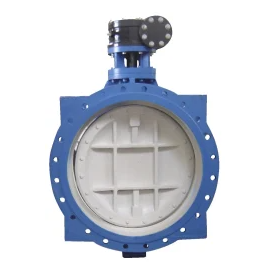Hp Butterfly Valve Maximizing Efficiency
To maximize efficiency with an HP butterfly valve, several factors should be considered. Here are some strategies for optimizing the efficiency of an HP butterfly valve:
Proper Sizing and Selection:
Selecting the correct size of the HP butterfly valve is crucial for maximizing efficiency. The valve size should match the flow requirements of the system. Undersized valves can cause excessive pressure drop and flow restrictions, while oversized valves may result in poor sealing and inefficient operation. Proper sizing ensures optimal flow rates and reduces energy consumption.
Streamlined Flow Path:
HP butterfly valves are designed to have a streamlined flow path that minimizes pressure drop and energy loss. The valve body and disc are engineered to create a smooth, unobstructed flow passage. This design feature enhances the efficiency of the valve by reducing turbulence and improving flow characteristics.
Low Torque Operation:
HP butterfly valves are designed to operate with low torque, enabling efficient actuation and reducing energy requirements. The valve's disc and shaft are engineered to minimize friction and resistance, resulting in smooth and effortless operation. Low torque operation not only improves efficiency but also extends the life of the actuator and reduces wear and tear.
High Cv Value:
The Cv value of a valve represents its flow capacity and is an important factor in maximizing efficiency. HP butterfly valves are designed with high Cv values, allowing for high flow rates with minimal pressure drop. Higher Cv values enable efficient fluid control and reduce energy consumption by minimizing the pumping power required.
Tight Shut-Off Capability:
HP butterfly valves are known for their excellent shut-off capability, ensuring reliable sealing and preventing leakage. Proper sealing between the disc and seat is essential to minimize leakage when the valve is in the closed position. The tight shut-off capability of the valve enhances efficiency by preventing unnecessary fluid loss and maintaining system integrity.
High-Quality Materials and Coatings:
Using high-quality materials and coatings for HP butterfly valves is essential for efficiency and longevity. The valve body, disc, and seat should be made from materials that offer excellent corrosion resistance and durability. Additionally, utilizing appropriate coatings or linings on the valve components enhances their resistance to wear, erosion, and chemical attack, ensuring long-term efficiency and reliability.
Regular Maintenance and Inspection:
Regular maintenance and inspection of HP butterfly valves are crucial for maximizing efficiency. Routine maintenance activities, such as lubrication, cleaning, and seal replacement, ensure smooth operation and prevent issues like sticking or leakage. Regular inspections help identify any performance degradation or potential problems, allowing for timely repairs or replacements.
System Monitoring and Control:
Implementing a comprehensive system monitoring and control system can further optimize the efficiency of HP butterfly valves. Utilizing technologies such as pressure sensors, flow meters, and control systems enables real-time monitoring of system conditions. This allows for proactive adjustments and preventive actions to optimize valve performance based on changing system requirements, further improving efficiency.
Training and Operator Awareness:
Providing proper training to system operators and raising awareness about the importance of efficient valve operation can significantly impact efficiency. Operators should be trained on valve operation procedures, including proper opening and closing techniques to minimize pressure surges and ensure optimal flow control. Operator awareness of valve performance indicators and the ability to recognize signs of inefficiency can lead to timely corrective actions.
By considering these strategies and implementing them appropriately, the efficiency of an HP butterfly valve can be maximized, resulting in improved fluid control, reduced energy consumption, and enhanced system performance.



Comments
Post a Comment